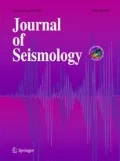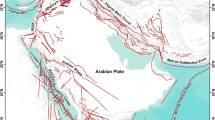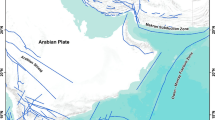Abstract
In this paper, a new probabilistic seismic hazard assessment (PSHA) is presented for Peninsular India. The PSHA has been performed using three different recurrence models: a classical seismic zonation model, a fault model, and a grid model. The development of a grid model based on a non-parameterized recurrence model using an adaptation of the Kernel-based method that has not been applied to this region before. The results obtained from the three models have been combined in a logic tree structure in order to investigate the impact of different weights of the models. Three suitable attenuation relations have been considered in terms of spectral acceleration for the stable continental crust as well as for the active crust within the Gujarat region. While Peninsular India has experienced large earthquakes, e.g., Latur and Jabalpur, it represents in general a stable continental region with little earthquake activity, as also confirmed in our hazard results. On the other hand, our study demonstrates that both the Gujarat and the Koyna regions are exposed to a high seismic hazard. The peak ground acceleration for 10 % exceedance in 50 years observed in Koyna is 0.4 g and in the Kutch region of Gujarat up to 0.3 g. With respect to spectral acceleration at 1 Hz, estimated ground motion amplitudes are higher in Gujarat than in the Koyna region due to the higher frequency of occurrence of larger earthquakes. We discuss the higher PGA levels for Koyna compared Gujarat and do not accept them uncritically.
















Similar content being viewed by others
References
Akkar S, Bommer JJ (2010) Empirical equations for the prediction of PGA, PGV, and spectral accelerations in Europe, the Mediterranean Region, and the Middle East. Seismol Res Lett 81 (2):10.1785/gssrl.81.2.195
Anbazhagan P, Vinod JS, Sitharam TG (2009) Probabilistic seismic hazard analysis for Bangalore. Nat Hazards 48:145–166
Atkinson G, Boore D (1995) New ground motion relations for eastern North America. Bull Seism Soc Am 85:17–30
Atkinson G, Boore DM. (2006) Earthquake ground-motion prediction equations for Eastern North America. Bull Seism Soc Am 96:2181–2205. doi:10.1785/0120050245
Atkinson GM, Bommer JJ, Abrahamson NA (2014) Alternative approaches to modeling epistemic uncertainty in ground motions in probabilistic seismic-hazard analysis. Seismol Res Lett 85(6):1141–1144. doi:10.1785/0220140120
Basu S, Nigam NC (1977) Seismic risk analysis of Indian Peninsula. In: Proceedings 6th World Conf. on Earth Eng., pages 782–788, New Delhi India
Bȧth M (1965) Lateral inhomogeneities in the upper mantle. Tectonophysics 2:483–514
Baumbach M, Grosser H, Schmidt H G, Paulat A, Rietbrock A, Ramakrishna Rao C V, Solomon Raju P, Sarkar D, Mohan I (1994) Study of foreshocks and aftershocks of the intraplate Latur earthquake of September 30, 1993, India. In: Gupta HK (ed) Latur Earthquake, pp 33–63. New Delhi India, Geol Soc India Mem
Beauval C, Scotti O, Bonilla F (2006) The role of seismicity models in probabilistic seismic hazard estimation: comparison of a zoning and a smoothing approach. Geophys J Int 162(2):584–595
Bhatia SC, Kumar MR, Gupta HK (1999) A probabilistic seismic hazard map of India and adjoining regions. Ann Geofis 42:1153–1166
Bilham R, Stewart IS, Vitafinzi C (1999) Slip parameters for the Rann of Kachchh, India, 16 June 1819 earthquake quantified from contemporary accounts Coastal Tectonics, pp 295–319. Geol. Soc. London Spec. Publ.
Bommer J, McQueen C, Salazar W, Scott S, Woo G (1998) A case study of the spatial distribution of seismic hazard (El Salvador). Nat Hazards 18:147–168
Boore DM (1983) Stochastic simulation of high-frequency ground motion based on seismological models of the radiated spectra. Bull Seism Soc Am 73:1865–1894
Brune J N (1970) Tectonic stress and the spectra of seismic shear waves from earthquakes. J Geophys Res 75(26):4997–5009
BSSC (2001) NEHRP Recommendations, Part 1: Provisions; prepared by the Building Seismic Safty Council for the Federal Emergency Management Agency, Report No FEMA (368), Washington, D. C., USA.
Campbell KW (2003) Prediction of strong ground motion using the hybrid empirical method and its use in the development of ground-motion (attenuation) relation in eastern North America. Bull Seism Soc Am 93:1012–1033
Chiou BS-J, Youngs RR (2008) An NGA model for the average horizontal component of peak ground motion and response spectra. Earthq Spectr 24:173–215. doi:10.1193/1.2894832
Choubey VD (1971) Narmada-son lineament. Nature Phys Sci 232:38–40
Christophersen A, Smith EGC (2000) A global model for aftershock behaviour. In: Proceedings of the 12th World conference on Earthquake Engineering, Auckland, New Zealand, 2000. 30th January–4th
Cornell CA (1968) Engineering seismic risk analysis. Bull Seism Soc Am 58(5):1583–1606
Crespo Álvarez MJ, Martinez Cutillas FJ, Marti Rodriguez J (2014) Seismic hazard of the Iberian Peninsula: evaluation with kernel functions. Nat Hazards Earth Syst Sci 14:1309–1323
Dahm T, Becker D, Bischoff M, Cesca S, Dost B, Fritschen R, Hainzl S, Klose CD, Kühn D, Lasocki S, Meier Th, Ohrnberger M, Rivalta E, Wegler U, Husen S (2013) Recommendation for the discrimination of human-related and natural seismicity. J Seismol 17(1):197–202. doi:10.1007/s10950--012--9295--6
Das R, Wason HR, Sharma ML (2013) General orthogonal regression relations between body-wave and moment magnitudes. Seismol Res Lett 84(2):219–224. doi:10.1785/0220120125
Frankel A (1995) Mapping seismic hazard in the Central and Eastern United States. Seismol Res Lett 66(4):4–8
Gahalaut VK, Kalpna VK, Singh SK (2004) Fault interaction and earthquake triggering in the Koyna-Warna region. India Geophys Res Lett 31(1–4)
GEM (2014) Global Earthquake Model, 2014. http://www.globalearthquakemodel.org. Last accessed 22
GSI (2000) Seismotectonics Atlas of India and its Environs, Geological Survey of India
Gubin IE (1968) Seismic zoning of Indian Peninsula. Bull Seism Soc Am 5:109–139
Guha S K, Gosavi P D, Varma M M, Agarwal S P, Padale JG, Marwadi SC (1970) Recent seismic distribution in the Shivajisagar Lake area of the Koyna hydroelectric project, Maharastra, India, comprehensive report up to June 1969. Technical report, Khadakwasla, Poona-24, India
Guha SK (1962) Seismic regionalization of India, Sec. Symp. Earthquake Eng. pp 191–207, University of Roorkee
Gupta HK (1992) Reservoir-Induced Earthquakes. Elsevier Scientific Publishing, Amsterdam, p 335
Gupta ID, Joshi RG, Rambabu V (1992) Analysis of Some Significant Accelerograms of Koyna Dam Earthquakes Using Improved Data Processing Techniques. Technical memorandum,Ministry of Water Resources, Central Water and Power Research Station
Gutenberg B, Richter CF (1944) Frequency of earthquakes in California. Bull Seism Soc Am 34:185–188
Iyengar RN, Raghukant STG (2004) Attenuation of strong ground motion in peninsular India. Seismol Res Lett 75(4):530–540
Jaiswal K, Sinha R (2007) Probabilistic seismic-hazard estimation for peninsular India. Bull Seism Soc Am 91(1B):318–330
Joyner WB, Boore DM (1981) Peak horizontal acceleration and velocity from strong-motion records including records from the 1979 Imperial Valley, California, earthquake. Bull Seism Soc Am 71:2011–2038
Kaila KL, Rao NM (1979) Seismic zoning map of the Indian subcontinent. Geophys Res Bull 17:293–301
Khatri KN, Rogers AM, Algermissen ST (1984) A seismic hazard map of India and adjacent areas. Tectonophysics 108:93–134
Krishna J (1959) Seismic zoning of India Earthquake Eng Seminar. Roorkee University, India, pp 32–38
Kulkarni RB, Youngs RR, Coppersmith KJ (1984) Assessment of confidence intervals for results of seismic hazard analysis. In: Proceedings of the Eighth World Conference on Earthquake Engineering, volume 1, pages 263–270, San Francisco
Menon AT, Corigliano Ornthammarath M, Lai CG (2010) Probabilistic seismic hazard macrozonation of Tamil Nadu in Southern India. Bull Seism Soc Am 100 (3):1320–1341. doi:10.1785/0120090071
Molina S, Lindholm CD, Bungum H (2001) Probabilistic seismic hazard analysis: zoning free versus zoning methodology. Bollettino di Geofisica Teorica ed Applicata 42:19–39
Murthy KSR, Subramanyam V, Subramanyam A S, Murty GPS, Sarma KVLNS (2010) Landocean tectonics (LOTs) and the associated seismic hazard over the Eastern Continental Margin of India (ECMI). Earthquake Hazards 55(2):167–175
Naqvi SM, Divakara Rao V, Narain H (1974) The protocontinental growth of Indian shield and antiquity of its rift valleys. Precambrian Res 1:345–398
Nath SK, Thingbaijam KKS (2012) Probabilistic seismic hazard assessment of India. Seismol Res Lett 83(1). doi:10.1785/gssrl.83.1.135
NDMA (2011) Development of probabilistic hazard map of India. http://ndma.gov.in/ndma/disaster/earthquake/PSHATechReportMarch%202011.pdf. Report
Oldham T (1883) A catalogue of Indian earthquakes from the earliest times to the end of 1869 A.D. MGSi, XIX: Part. 3
Ordaz M, Aguilar A, Arbdeda J (2014) Program for computing seismic hazard. Instituto de Ingenieria, Instituto de Ingenieria, UNAM, Mexico, Ver. 1.1.
Ornthammarath T, Lai CG, Menon A, Corigliano M, Dodagoudar GR, Gonavaram K (2008) Seismic hazard at the historical site of Kancheepuram in Southern India. In: The 14th World Conference on Earthquake Engineering, p 1–8, Beijing, October 12-17
Parvez IA, Gusev AA, Panza GF, Anatoly GP (2001) Preliminary determination of the interdependence among strong-motion amplitude, earthquake magnitude and hypocentral distance for the Himalayan region. Geophys J Int 144:577–596
Parvez IA, Vaccari F, Giuliano FP (2003) A deterministic seismic hazard map of India and adjacent areas. Geophys J Int 155:489–508
Petersen MD, Rastogi BK, Echweig ES, Harmsen SC, Homberg JS (2004) Sensitivity analysis of seismic hazard for the northwestern portion of the state of Gujarat. India Tectonophysics 390 (1-4):105–115
Pezeshk S, Zandieh A, Tavakoli B (2011) Hybrid empirical ground-motion prediction equations for Eastern North America using NGA models and updated seismological parameters. Bull Seism Soc Am 101(4):1859–1870. doi:10.1785/0120100144
Raghukant STG, Iyengar RN (2007) Estimation of seismic spectral acceleration in Peninsular India. J Earth Syst Sci 116(3):199–214
Ramalingeswara Rao B, Sitapathi Rao P (1984) Historical seismicity of Peninsular India. Bull Seism Soc Am 74(6):2519–2533
Rastogi B K (2001) Ground deformation study of mw 7.7 bhuj earthquake of 2001. Episodes 24 (3):160–165
Rastogi BK (1992) Seismotectonics inferred from earthquakes and earthquake sequences in India during the 1980s. Curr Sci India 62(1–2):101–108
Richter CF (1958) Elementary Seismology. WH Freeman & Co, San Francisco, USA
Seeber L, Armbruster J G, Jacob K H (1999) Probabilistic assessment of earthquake hazard for the state of Maharashtra. Unpublished Report, Government of Maharashtra, Earthquake Rehabilitation Cell Mumbai
Singh SK, Bansal BK, Bhattacharya SN, Pacheco JF, Dattatrayam RS, Ordaz M, Suresh G, Kamal, Hough S E (2003) Estimation of ground motion for Bhuj (26th January 2001. Mw = 7.6) and for future earthquakes in India. Bull Seism Soc Am 93(1):353–370
Singh SK, Ordaz M, Dattatrayam RS, Gupta HK (1999) A spectral analysis of the May 21, 1997, Jabalpur, India earthquake (Mw 5.8) and estimation of ground motion from future earthquakes in the Indian shield region. Bull Seism Soc Am 86(6):1620–1630
Sitharam TG, Kolathayar S (2013) Seismic hazard analysis of India using areal sources. J Asia Earth Sci 62:647–653
Tondon AN (1956) Zoning of India liable to earthquake damage. Ind J Meteorol Geophys 10:137–146
Tondon AN, Chaudhury HM (1968) Koyna earthquake of December Scientific report no. 59, India Meteorol. Dept., 1968
Toro GN (2002) Modification of the Toro et al. (1997) attenuation equations for large magnitudes and short distances. Risk Engineering, http://www.riskeng.com/PDF/atten_toro_extended.pdf
Toro GN (1997) Model of strong ground motion in eastern and central North America: best estimates and uncertainties. Seismol Res Lett 68:41–57
USGS (2014) Shuttle Radar Topography Mission (SRTM). Available at http://earthexplorer.usgs.gov/. Last accessed 11 March 2014
Valdiya KS (1973) Tectonic framework of India: a review and interpretation of recent structural and tectonic studies. Geophys Res Bull 11:79–114
Van Stiphout T, Zhuang J, Marsan D (2012) Seismicity declustering, Community Online Resource for Statistical Seismicity Analysis. Available at http://www.corssa.org. doi:10.5078/corssa-52382934
Vere-Jones D (1992) Staticle methods for the description and display of earthquake catalogues. In: Walden AT, Guttorp P (eds) Statistics in the Environmental and Earth Sciences, pp 220–246. Edward Arnold, London
Verma M, Bansal BK (2013) Seismic hazard assessment and mitigation in India: an overview. Int J Earth Sci 102:1203–1218
Verma RK, Banerjee P (1992) Nature of continental crust along the Narmada-Son Lineament inferred from gravity and deep seismic sounding data. Tectonophysics 202(2):375–397. doi:10.1016/0040--1951(92)90121--L
Vipin KS, Anbazhagan P, Sitharam TG (2009) Estimation of peak ground acceleration and spectral acceleration for south India with local site effects: probabilistic approach. Nat Hazards 9:865–878
Wells DL, Coppersmith KJ (1994) New empirical relationships among magnitude, rupture length, rupture width, rupture area and surface displacement. Bull Seism Soc Am 84(4):974–1002
Wesnousky SG (1994) The Gutenberg-Richter or characteristic earthquake distribution, which is it Bull Seism Soc Am 86(6):1940–1959
Wiemer S (2001) software package to analyze seismicity:ZMAP. Seismol Res Lett 72(2):374–383
Woo G (1996) Kernel estimation methods for seismic hazard area source modelling. Bull Seism Soc Am 86(2):353–362
Yanger Walling M, Mohanty WK (2009) An overview on the seismic zonation and microzonation studies in India. Earth-sci Rev 96:67–91
Youngs RR, Coppersmith KJ (1985) Implication of fault slip rates and earthquake recurrence models to probabilistic seismic hazard estimates. Bull Seism Soc Am 75(4):939–964
Zhao XJ, Zhang J, Asano A, Ohno Y, Oouchi T, Takahashi T, Ogawa H, Irikura K, Thio HK, Somerville PG, Fukushima Y, Fukushima Y (2006) Attenuation relations of strong ground motion in Japan using site classification based on predominant period. Bull Seism Soc Am 96:898–913. doi:10.1785/0120050122
Acknowledgments
A number of colleagues have helped to improve our work. Particularly, we would like to thank Mario Ordaz for helping us in exploring the new capabilities of CRISIS2014 and Gordon Woo for providing the KERGRID code and helping with implementing the grid model into CRISIS2014. We gratefully appreciated three anonymous reviews and the detailed review of Julian Bommer, which caused us more work, but certainly improved the manuscript. Finally, we thank the Royal Norwegian Embassy in India, New Delhi for funding the Indo-Norwegian (EQRisk) research project, R-1-165. Ashish and I. A. Parvez also acknowledge ARiEES, project of CSIR.
Author information
Authors and Affiliations
Corresponding author
Rights and permissions
About this article
Cite this article
ᅟ, A., Lindholm, C., Parvez, I.A. et al. Probabilistic earthquake hazard assessment for Peninsular India. J Seismol 20, 629–653 (2016). https://doi.org/10.1007/s10950-015-9548-2
Received:
Accepted:
Published:
Issue Date:
DOI: https://doi.org/10.1007/s10950-015-9548-2




